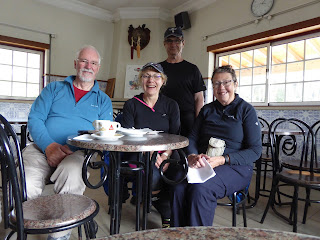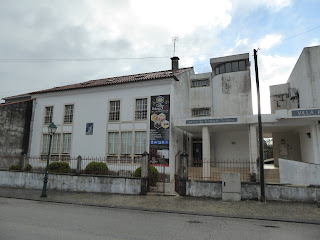After yesterday's wet, but bearable, day of walking we were rewarded with a fine evening. The clouds had broken by the time we went to bed and things looked promising. The weather forecast was still ominous, but the reality outside looked better. During the night both of us were woken from our slumbers by the sound of torrential rain. Not a good noise.
When we finally awoke the day didn't look too bad. There were lots of clouds, in 50 shades of grey, but it wasn't raining.
We took a chance and opted to leave off our weather-proofs. Because of the uncertainness of the weather currently we are only planning to walk relatively short distances each day. This is also, to some degree, determined by the availability of suitable stopping places. We don't really want to faced with, say, a twelve to fourteen kilometres trek, in the sort of rain we've been having, simply because there is no available accommodation in between. Today we have booked to stay at the Casa de Tourisma in Rabaçal about 15km away.
We started with a steady climb out of Ansiao and we're soon into a forested area, following a good track. It was obvious that there had been a lot of rain last night but the going was remarkably good.
The track was mainly gravel and other small to medium sized stones which had drained amazingly well, allowing us to make good progress.
In our Camino tradition we hadn't bothered with breakfast at the hotel, mainly because they only served it from 9:00 onwards, by which time we were well along our route. We passed through several very small villages, all in very pleasant walking conditions, eventually meeting with a main road and a cafe. Breakfast time we thought. Inside the cafe we were greeted by Brigitte and Pascal who had arrived just before us and we're also breakfasting there.
We chatted in French for a while and even took photographs of each other before they departed
I mentioned that we had decided not to wear our waterproofs when we started, but we still had our windproof jackets on, as initially it was a little chilly. By now though we needed to take off these as the sun was becoming quite warm. Amazingly after last night's rain, the weather was getting better and better. All the little streams were flowing rapidly but we still haven't been troubled by rain. That is until we neared the small town of Junqueria.
The guide says that the track goes near, but not through, the town and the path was taking us off to the side until we met our first problem of the day. The track we should have taken was completely flooded. We'd noticed that the fields, mainly vineyards, around here often had large flooded zones, but this time a flood zone extended completely across our track.
We walked right up to it to see if we could somehow get through. It was impossible, the water even at the edge, was more than deep enough to completely cover our boots, further onwards it looked to be substantially deeper. Time to look at the GPS mapping. Fortunately there was an alternative route available along a nearby road. This was hardly any longer than our planned track and we could see that it was unaffected by the flood.
After this little diversion we encounter no other problems partly because at a small village further on when we stopped for a short coffee break, a local guy, who ran the cafe advised us to ignore the official route, across country, and stick to the road. The official route, he said was much longer, and likely to be affected by the flooding. Taking his advice we started on the road, which wasn't very busy, soon making it to our destination of Rabaçal.
In Rabaçal we encountered our French companions again. Brigitte and Pascal had stuck religiously to the route, including fording the flood we encountered, and some others later in the off-road section we had avoided. They said that in some places the water was nearly knee-deep. We were glad of the advice we had been given earlier.
Not only had we managed to avoid all the floods, but we had walked the whole of our distance for today without a drop of rain. In fact it was a rather warm walk eventually.
We soon found our lodging for tonight, it is situated on the main street of Rabaçal immediately next door to the town museum. A small guide book we are using says that if the door is locked, which it was, we needed to go to the museum next door and ask them to contact the correct person. The museum was closed when we arrived, we had to wait for 45 minutes in the bar opposite until the museum eventually opened. The museum lady duly contacted the "appropriate person" by phone and some while later a woman arrived to let us in.
This lady didn't seem very pleased with having to come to the hostel to let us in, she was rather terse and with little to say other than taking our money and passport details, and grudgingly stamping our credentials, before leaving again.
The place is a rather fine hostel with about 20 nice rooms, but we were the only residents. We soon settled in, but also soon discovered that there was no hot water. We had been told that we would have to run the hot tap for a few minutes before we could expect hot water. We tried, but after about 10 to 15 minutes running and still no hot water we decided something was wrong. Back to the museum to ask the lady there to contact the hostel lady with the news. (There was a contact number posted at the entrance but nobody ever answered it).
We had to wait for about 45 minutes, and pestered the museum lady again before any action was taken. The hostel lady at last returned and obviously had decided that we were calling her in a wild goose chase, because we couldn't deal with a small delay in getting hot water. However when she tried, and only got cold water she realised that something was actually wrong. She then rang someone else and a while later a couple of blokes arrived, did something, and got the system working. All this messing about took about two hours before we could have a shower, of even a decent wash. All of this was rather strange as we've been constantly amazed at the hospitality of all the Portuguese people we have met. They've even made light of our childish attempts at even the simplest Portuguese phrase, "It's a hard language, don't worry about it" had been the general response. It was so out of character of the Portuguese people in general.
We did eventually get the hot water and our showers, the room was warm and eventually we had a good night's rest. Tomorrow we are planning to have a long day. Today was very interesting but a rather short walk and the afternoon seemed to be wasted. If we hadn't stopped here though we would have had to walk a long way extra to the next available place.
Tomorrow we aim to walk all the way to Coimbra, which is about 30kms (19mls). We hope to be able to do it as we want to spend a day there looking around what promises to be a very interesting university city. If, by any chance, we can't manage the whole 30km there is an alternative place to stay at about 20kms, and we know that we can walk that far without problems. Here's hoping!

















